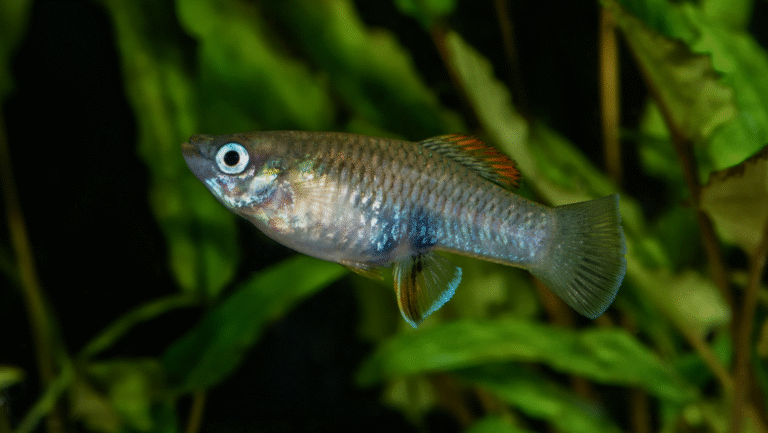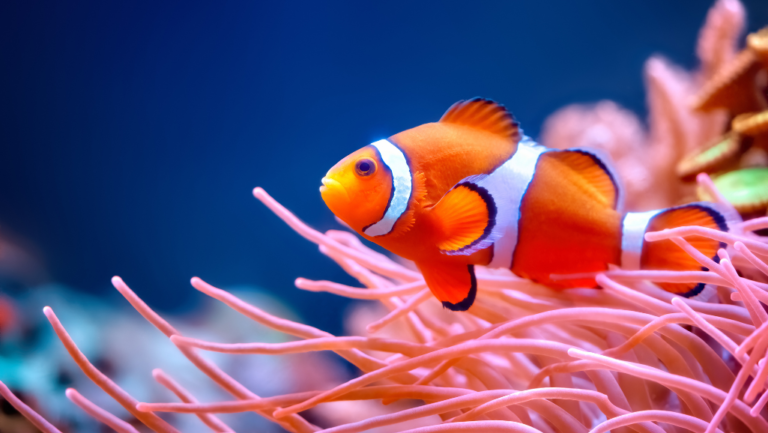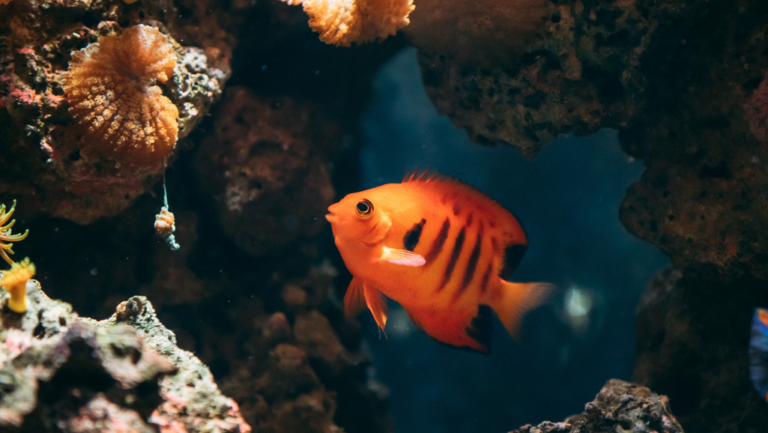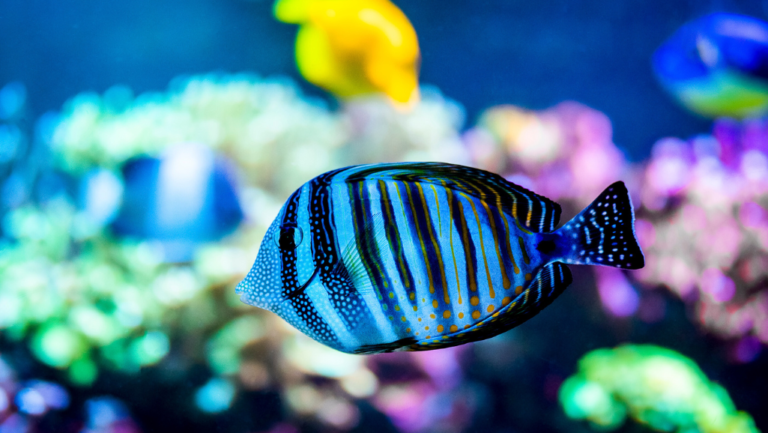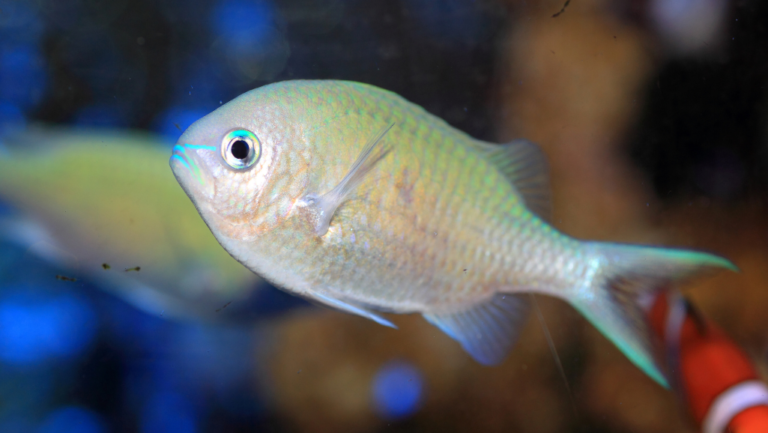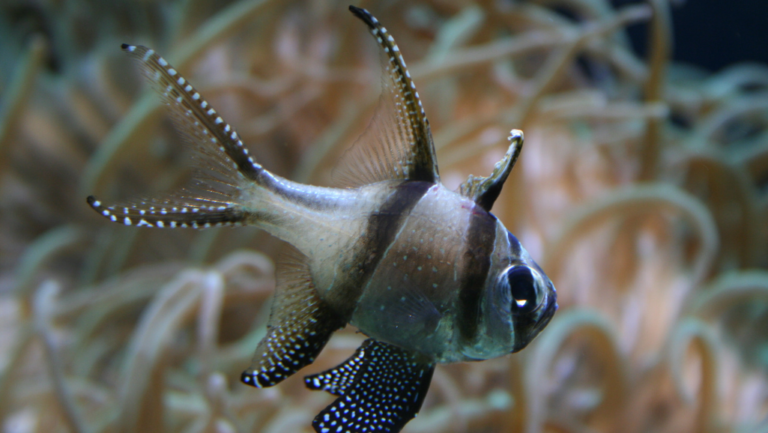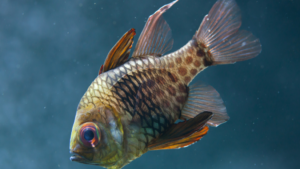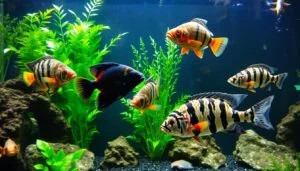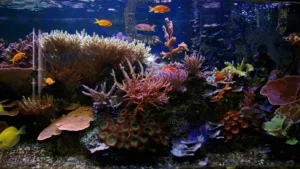Bright, bold, and beginner-friendly, the pajama cardinalfish is a compact marine species reaching about 3.3 inches (8.5 cm). Instantly recognizable, this cardinalfish shows a dark vertical waistband, red eyes, and orange‑red spots on the rear half.
This small reef fish thrives in calm, shaded areas and is widely distributed across the tropical Indo‑Pacific — from Java and the Philippines through Fiji and Tonga to the Great Barrier Reef. Pajama cardinals school peacefully by day under overhangs and become active at dusk, so they do best in low‑light aquarium zones that mimic this rhythm.
Hobbyists consider Sphaeramia nematoptera hardy and well suited to saltwater aquariums. A minimum 30‑gallon tank with plenty of hiding spots supports a small group; evening or targeted low‑light feedings help timid individuals take food confidently.
Whenever possible, choose captive‑bred stock: these fish adapt quickly, accept prepared foods, and support sustainable hobby practices. This guide covers practical Pajama Cardinalfish Care — tank setup, feeding, and breeding basics (males mouthbrood eggs; incubation varies with conditions). For captive‑bred availability, see LiveAquaria for current stock: LiveAquaria.
Key Takeaways
- The pajama cardinalfish is a hardy, small reef species ideal for beginners.
- Identify them by a dark waistband, red eyes, and spotted rear half.
- Keep small groups in a 30‑gallon+ aquarium with shaded overhangs and caves.
- Target feed at low light; captive‑bred fish settle faster and accept foods readily.
- Males mouthbrood fertilized eggs (incubation commonly ranges around 7–21 days depending on temperature and conditions) — breeding is achievable with basic husbandry.
Meet the pajama cardinalfish: identification, behavior, and origins
Sphaeramia nematoptera is a compact reef species with unmistakable markings. Adults reach about 3–3.3 inches (7.5–8.5 cm) and typically live around two to five years in home aquariums with good care.
How to recognize Sphaeramia nematoptera:
- Silvery body with a greenish‑yellow face and prominent red or orange eyes.
- A bold, dark vertical mid‑body “waistband” with red/orange spots on the rear half; juveniles display darker dots that redden as they mature.
- Males may show a slightly longer second dorsal fin, but sex is most reliably confirmed by courtship behavior and pairing rather than fin shape alone.
Origins and natural habits
Native to the tropical Indo‑Pacific, the pajama cardinalfish occurs from Java and the Philippines eastward to Tonga and Fiji, up to the Ryukyu Islands, and along parts of the Great Barrier Reef. In the wild this marine species is most often found in sheltered bays and lagoons at shallow depths — commonly reported between about 1 and 14 meters — where calm water and structure offer protection.
Daily rhythms and social life
During daylight hours small groups school tightly among rockwork and branching corals, often sheltering in shaded overhangs and crevices. At dusk these groups disperse to forage across sand and rubble for small crustaceans; matching feeding times to their crepuscular habits (around lights‑out) improves feeding uptake in the aquarium. Natural predators include larger piscivores that patrol reef flats, so providing secure hideouts reduces stress and mimics their wild habitat.
Set up your marine aquarium for success: tank, lights, and daily care
Recreating calm reef microhabitats in your home aquarium encourages natural behavior and long-term health for pajama cardinals. Below are clear, actionable steps to choose the right tank, set up filtration and flow, and maintain water quality.
Right tank and aquascape
Tank selection: Start with at least a 30-gallon tank for a small group or pair; consider 40–55 gallons if you plan a larger school or a fuller reef aquascape. Bigger water volume equals more stable water quality and easier long-term care.
Aquascape: Stack live rock to create shaded overhangs, caves, and ledges where pajama cardinalfish can shelter during the day. Leave open mid‑level swimming space so they can school comfortably. Use secure rockwork to prevent collapses that would stress fish and damage the aquascape.
Filtration, heating, and cycling
Filtration: Aim for steady biological filtration and gentle mechanical polishing. For tanks that may host breeders, keep a sponge filter on hand for larval and brood support. Protein skimmers and refugia help maintain water chemistry for reef systems.
Heating & stability: Maintain stable temperatures in the typical reef range — roughly 24–27°C (75–80°F). Rapid swings stress fish and can extend mouthbrooding times. Fully cycle the tank before adding fish and allow several weeks of biological stabilization.
Lighting and flow
Lighting: Pajama cardinalfish prefer lower light pockets within a tank. Use dimmable LEDs or mounting options to create shaded zones over rockwork; if you keep photosynthetic corals, position them where PAR is appropriate and provide refuges with reduced intensity for the cardinals.
Water flow: Aim for moderate, indirect circulation. Powerheads that create gentle, turbulent pockets rather than strong continuous jets are ideal — target calm zones near rockwork and slightly higher flow over open sandbeds where they feed at dusk.
Recommended water parameters (micro‑specs)
For consistent health and color, maintain:
- Temperature: 24–27°C (75–80°F)
- Salinity: 1.023–1.025 specific gravity
- pH: 8.1–8.4
- Ammonia/Nitrite: 0 ppm; Nitrate: <20 ppm (lower is better for reef aquariums)
Daily and weekly care for quality water
Perform small, regular water changes (10–20% weekly or biweekly depending on stocking and nutrient load). Test key parameters frequently during the first months and after any system changes. Remove uneaten food promptly and clean skimmer/filter socks on a schedule to maintain water quality.
For breeders, keep an aged sponge filter available and consider a dedicated small sump or quarantine tank for larval rearing. Overall, stable water parameters and steady filtration deliver the best care results for these marine fish.
Community planning
When adding pajama cardinals to your aquarium, prioritize peaceful, reef‑safe tankmates that won’t outcompete or bully a small group. These saltwater fish are relatively timid during feeding and do best with calm species that occupy different niches.
Suggested tankmates (Do)
- Small gobies and shrimp gobies — occupy the sandbed and rarely disturb mid‑water schooling.
- Blennies and small, peaceful wrasses (e.g., some fairy or flasher wrasses) — generally reef‑safe and compatible.
- Cerith snails, small hermits, and cleaning shrimp — excellent cleanup crew without threatening the cardinals.
Species to avoid (Don’t)
- Large, aggressive wrasses, some tangs, and known fin‑nippers — these can harass or injure pajama cardinals.
- Large, aggressive feeders or territorial predators that will dominate feeding times.
Feeding routine and timing
Feed 2× daily for adults (up to 3× if highly active or during breeding), rotating a mix of prepared and frozen foods to meet nutritional needs. Offer:
- Frozen mysis shrimp (highly recommended) — a staple for color and growth.
- Prepared micro‑pellets or marine flakes formulated for carnivorous reef fish.
- Occasional live or thawed brine/mysis shrimp to stimulate appetite.
Target feed just before and shortly after lights‑out to match their crepuscular feeding behavior — this helps timid individuals get food without heavy competition. For portioning, offer only what they can consume in 1–2 minutes to avoid excess waste.
“Target feed just before and after lights-out to match their crepuscular foraging and help timid fish eat confidently.”
Water quality and maintenance
- Perform small, regular water changes (10–20% weekly or 10% biweekly depending on stocking) to keep nitrates low in a reef setup.
- Monitor temperature and salinity (see micro‑specs in the tank setup block) and test ammonia/nitrite frequently during new setups or after changes.
- Remove uneaten food promptly and clean skimmer/filter socks on a schedule to maintain water quality.
Tip: Choose captive‑bred pajama cardinals when possible — they settle more quickly, accept prepared foods, and reduce pressure on wild populations. If you want help selecting compatible species, consult a species compatibility list before purchasing to ensure a peaceful community tank.
Breeding pajama cardinalfish: step-by-step mouthbrooding and fry rearing
Breeding pajama cardinals (Sphaeramia nematoptera) is highly achievable for dedicated hobbyists. These cardinals form pairs and spawn at dusk; after fertilization the male collects and mouthbroods the eggs until hatching. Below is an ethical, step‑by‑step plan that emphasizes fish welfare and reliable results.
1. Identify a breeding pair
- Look for bonded behavior: one fish following or responding to the other during evening displays. Pairs often show courtship nudges and mutual guarding of a quiet crevice.
- Physical sexing is unreliable—males may show a slightly longer second dorsal fin, but pairing behavior is the clearest indicator.
2. Spawning and mouthbrooding (what to expect)
Spawning usually begins at dusk. The female deposits eggs and the male quickly gathers them into his mouth. Incubation time depends on temperature and water quality; hatching is commonly observed around day 7–21 under typical reef conditions (warmer temperatures shorten incubation). Monitor the male closely for changes in mouth opacity and egg appearance as development proceeds.
3. Ethical collection options (non‑stressful approaches)
If you choose to remove eggs for captive rearing, prioritize the male’s welfare. Two less invasive options:
- Wait and observe: some breeders allow the male to release fry directly into a protected rearing area inside the main tank (e.g., a breeder box) to reduce handling stress.
- Gentle transfer: if collection is required, move the male into a quarantine/rearing vessel with identical parameters and very low stress (dim lighting, minimal netting). Avoid prolonged air exposure and handle fish as little as possible.
4. Larval rearing system (simple, effective setup)
Recommended starter setup: a 5‑gallon blacked‑sided rearing tank (to reduce stress), heater, aged sponge filter, and a gentle slow drip exchange to the main system to stabilize chemistry. An egg tumbler (1.5″ PVC with ~800‑micron mesh and a fine airstone) also works for direct egg incubation — ensure gentle tumble and no air exposure.
- Target larval parameters: temperature ~25–27°C (77–80°F), salinity 1.023–1.025, stable pH and low ammonia (use sponge filtration and frequent testing).
- Maintain low, constant dim lighting or very low‑intensity 24‑hour light to encourage continuous hunting by newly hatched fry (many breeders use a small lamp or diffuse LED).
5. First foods and enrichment timeline
Successful early feeding is key to survival:
- Day 0–1 (post‑hatch): provide abundant rotifers (Brachionus spp.) at target densities; greenwater with Nannochloropsis paste (~1 cc/5 gal twice daily) improves rotifer nutrition and visibility for larvae.
- Day 4–7: enrich rotifers with HUFA supplements; continue frequent small feedings several times per day.
- Day ~10–14: introduce HUFA‑enriched brine shrimp nauplii gradually; overlap with rotifers for 5–7 days to ensure continuous food availability.
- Week 3: begin adding a fine dry larval diet optimized for marine larval stages while maintaining live foods.
6. Metamorphosis and grow‑out
Metamorphosis typically completes near day 30–36 depending on conditions. Move juveniles to a grow‑out tank at about 7–8 weeks when they feed reliably on chopped mysis and prepared juvenile diets. During grow‑out:
- Offer finely chopped mysis shrimp and high‑quality pellet/flake foods formulated for carnivorous marine fish.
- Separate overly aggressive or very shy individuals to reduce competition and improve overall survival.
“Keep an ammonia badge, maintain an aged sponge filter, and leave a small lamp on 24 hours to support continuous hunting for newly hatched fry.”
Troubleshooting and pro tips
- Low rotifer density is the most common early failure—monitor and maintain cultures or use concentrated supplies.
- Ammonia spikes kill larvae quickly—use sponge filters and do daily checks; perform micro water changes if levels creep up.
- If eggs become opaque or foul-smelling, remove them to prevent bacterial blooms; consider using an egg tumbler for controlled incubation.
- Document timings and temperatures—incubation and development vary with water temperature, so logging conditions helps refine your routine.
Ethics, legality, and final notes
Always prioritize fish welfare when breeding. Avoid unnecessary stress when handling males and eggs, and follow local regulations for breeding and selling marine fish. Many hobbyists find success with captive‑bred pajama cardinals and contribute to sustainable aquarium practices.
- Pairs may spawn every 2–3 weeks under good conditions; refine feeding and rearing to improve survival rates.
- Gentle, consistent feeding and careful water control give the best growth and health outcomes for fry and juvenile pajama cardinals.
Conclusion
Conclusion
With consistent routines and a thoughtfully designed aquarium, pajama cardinals reward keepers with years of healthy, schooling behavior and bright color. Keep care simple: provide low‑light refuges, calm water flow, and targeted feedings at dusk to match their natural activity.
Offer a varied, high‑quality diet — frozen mysis, finely chopped seafood, and appropriate pellets — and you’ll see growth and coloration improve over time. Breeding is practical for committed hobbyists: observe the male’s mouthbrooding, follow timed rearing steps, and separate fry when necessary to reduce competition.
Whenever possible, start with captive‑bred pairs for more resilient, well‑acclimated stock. For additional step‑by‑step Pajama Cardinalfish Care and resources, see our breeder and species pages or refer to trusted suppliers such as keeping the pajama cardinalfish.






